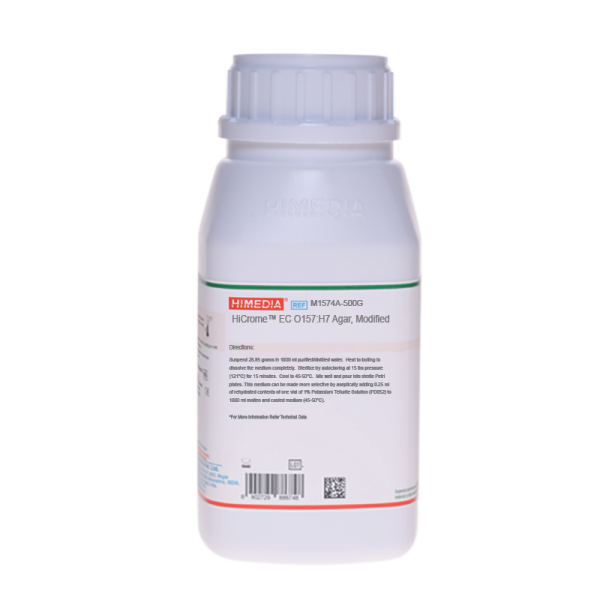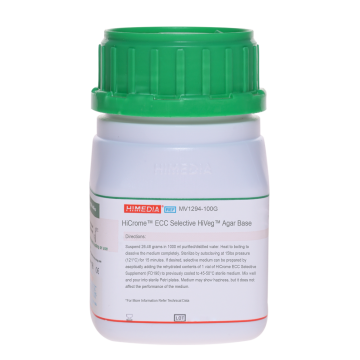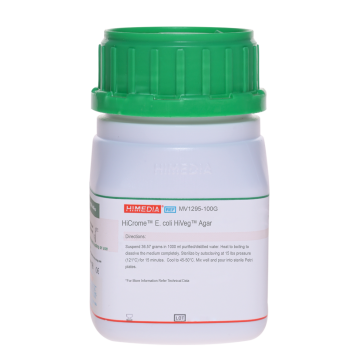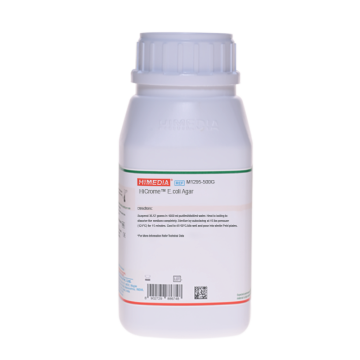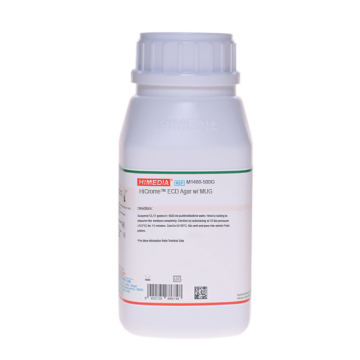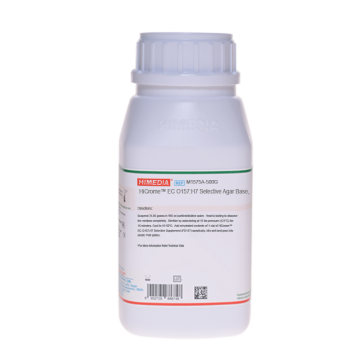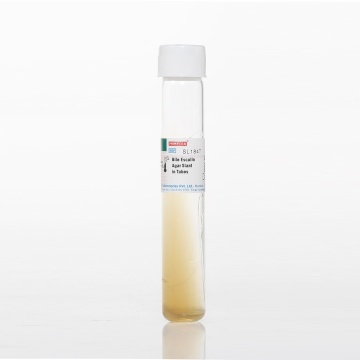 Your enquiry has been submitted
Your enquiry has been submitted
HiCrome™ EC O157 : H7 Agar, Modified
Intended Use
Recommended for isolation and differentiation of Escherichia coli O157:H7 from food, environmental samples.
Composition**
| Ingredients | g / L |
|---|---|
| Tryptone | 8.000 |
| Sorbitol | 7.000 |
| Bile salts mixture | 1.500 |
| Sodium lauryl sulphate (SLS) | 0.100 |
| Chromogenic mixture | 0.250 |
| Agar | 12.000 |
Final pH (at 25°C): 6.8±0.2
**Formula adjusted, standardized to suit performance parameters
Directions
Suspend 28.85 grams in 1000 ml purified / distilled water. Heat to boiling to dissolve the medium completely. Sterilize by autoclaving at 15 lbs pressure (121°C) for 15 minutes. Cool to 45- 50°C. Mix well and pour into sterile Petri plates. This medium can be made more selective by aseptically adding 0.25 ml of rehydrated contents of one vial of FD052 [PTe 1% Selective Supplement (1 ml per vial)] to 1000 ml molten and cooled medium (45-50°C).
Principle And Interpretation
Escherichia coli O157:H7 belongs to the Enterohaemorragic Escherichia coli (EHEC) group and it predominates as a food borne pathogen. E.coli O157: H7 was first recognized as a human pathogen in 1982 when two outbreaks of hemorrhagic colitis were associated with consumption of undercooked ground beef that has been contaminated with this organism (1).
HiCrome™ EC O157:H7 Agar is a chromogenic medium recommended for the isolation and differentiation of E.coli O157:H7 from food and environmental samples. HiCrome™ EC O157:H7 Agar is based on the formulation described by Rappaport and Henigh (2). The medium contains sorbitol as a fermentable carbohydrate and a chromogenic mixture instead of lactose and indicator dyes respectively. The chromogenic substrate is specifically and selectively cleaved by Escherichia coli O157: H7 resulting in a dark purple to magenta coloured moiety. E.coli give bluish green coloured colonies. Tryptone provides carbonaceous, nitrogenous compounds, vitamins and growth nutrients. Sodium chloride maintains osmotic equilibrium. Bile salts mixture and Sodium lauryl sulphate inhibits gram-positive organisms. Potassium tellurite selects the serogroups and inhibits Aeromonas species and Providencia species.
Type of specimen
Food samples.
Specimen Collection and Handling
For food samples, follow appropriate techniques for sample collection and processing as per guidelines (1). After use, contaminated materials must be sterilized by autoclaving before discarding.
Warning and Precautions
Read the label before opening the container. Wear protective gloves/protective clothing/eye protection/ face protection. Follow good microbiological lab practices while handling specimens and culture. Standard precautions as per established guidelines should be followed while handling specimens. Safety guidelines may be referred in individual safety data sheets.
Limitations
- Individual organisms differ in their growth requirement and may show variable growth patterns on the medium.
- Each lot of the medium has been tested for the organisms specified on the COA. It is recommended to users to validate the medium for any specific microorganism other than mentioned in the COA based on the user’s unique requirement.
- Further biochemical and serological test are necessary for confirmation.
Performance and Evaluation
Performance of the medium is expected when used as per the direction on the label within the expiry period when stored at recommended temperature.
Quality Control
Appearance: Cream to yellow homogeneous free flowing powder
Gelling: Firm, comparable with 1.2% Agar gel.
Colour and Clarity of prepared medium: Light amber coloured, clear to slightly opalescent gel forms in Petri plates
Reaction: Reaction of 2.88% w/v aqueous solution at 25°C. pH : 6.8±0.2
pH: 6.60-7.00
Cultural Response: Cultural characteristics observed after an incubation at 35-37°C for 18- 24 hours.
| Organism | Inoculum (CFU) | Growth | Recovery | Colour of Colony |
|---|---|---|---|---|
| **Bacillus spizizenii ATCC 6633 (00003*) | >=10⁴ | inhibited | 0 % | |
| Escherichia coli O157:H7 (NCTC 12900) | 50-100 | luxuriant | >=50% | dark purple-magenta |
| Escherichia coli ATCC 25922 (00013*) | 50-100 | luxuriant | >=50% | bluish green |
| Klebsiella pneumoniae ATCC 13883 (00097*) | 50-100 | luxuriant | >=50% | colourless-mauve, mucoid |
| Pseudomonas aeruginosa ATCC 27853 (00025*) | 50-100 | luxuriant | >=50% | colourless |
| Staphylococcus aureus subsp. aureus ATCC 25923 (00034*) | >=10⁴ | inhibited | 0% |
Key : *Corresponding WDCM numbers and **Formerly known as Bacillus subtilis subsp. spizizenii.
Storage and Shelf Life
Store between 15-25°C in a tightly closed container and the prepared medium at 2-8°C. Use before expiry date on the label. On opening, product should be properly stored dry, after tightly capping the bottle in order to prevent lump formation due to the hygroscopic nature of the product. Improper storage of the product may lead to lump formation. Store in dry ventilated area protected from extremes of temperature and sources of ignition Seal the container tightly after use. Product performance is best if used within stated expiry period.
Disposal
User must ensure safe disposal by autoclaving and/or incineration of used or unusable preparations of this product. Follow established laboratory procedures in disposing of infectious materials and material that comes into contact with sample must be decontaminated and disposed of in accordance with current laboratory techniques (3,4).
Reference
- Salfinger Y., and Tortorello M.L., 2015, Compendium of Methods for the Microbiological Examination of Foods, 5th Ed., American Public Health Association, Washington, D.C.
- Rappaport F. and Henigh E., 1952, J. Clin. Pathol., 5:361.
- Isenberg, H.D. Clinical Microbiology Procedures Handbook 2nd Edition.
- Jorgensen, J.H., Pfaller, M.A., Carroll, K.C., Funke, G., Landry, M.L., Richter, S.S and Warnock., D.W. (2015) Manual of Clinical Microbiology, 11th Edition. Vol. 1.
| Product Name | HiCrome™ EC O157 : H7 Agar, Modified |
|---|---|
| SKU | M1574A |
| Product Type | HiCrome™ |
| Physical Form | Powder |
| Origin | Animal |
| Packaging type | HDPE |
| References | 1.Isenberg, H.D. Clinical Microbiology Procedures Handbook. 2nd Edition.2.Rappaport F. and Henigh E., 1952, J. Clin. Pathol., 5:361.3.Jorgensen,J.H., Pfaller , M.A., Carroll, K.C., Funke, G., Landry, M.L., Richter, S.S and Warnock., D.W. (2015) Manual of Clinical Microbiology, 11th Edition. Vol. 1.4.Salfinger Y., and Tortorello M.L. Fifth (Ed.), 2001, Compendium of Methods for the Microbiological Examination of Foods, 5th Ed., American Public Health Association, Washington, D.C. |
| Customized Product Available | No |



